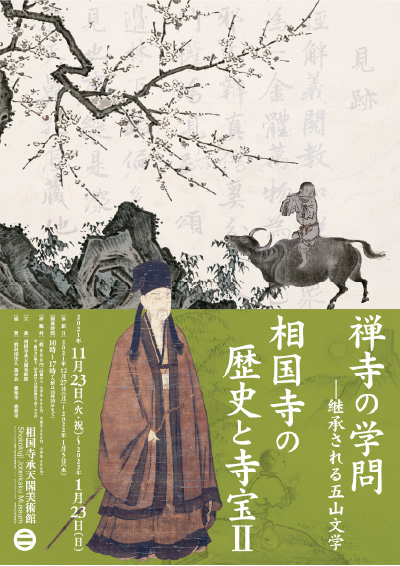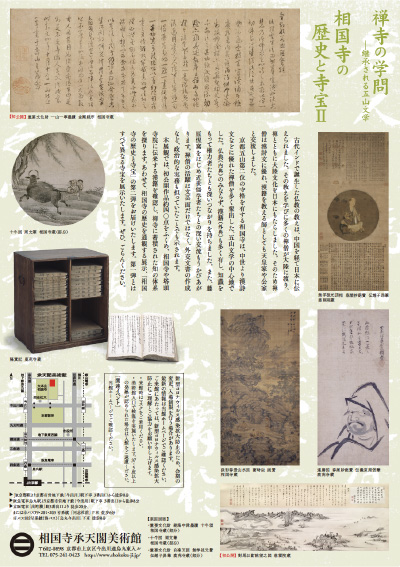EXHIBITION
Passing down the teachings of ZenThe Literature of the Five Mountains The History and Treasures of Shokokuji TempleⅡ
November 23rd, 2021 (Tue. and national holiday) to January 23rd, 2022 (Sun.)
Passing down the teachings of ZenThe Literature of the Five Mountains The History and Treasures of Shokokuji TempleⅡ
November 23rd, 2021 (Tue. and national holiday) to January 23rd, 2022 (Sun.)
About
Buddhist teachings originating in ancient India passed through China before arriving in Japan. Many Zen monks traveled to China to learn Buddhism and brought back the culture of the continent to Japan along with Zen. The Zen monks therefore excelled in Chinese poetry and became teachers of Chinese poetry for the Japanese emperor and nobles.
In Kyoto, Shokoku-ji Temple ranked No. 2 among the five Zen monastic centers and was the center of Gozan Bungaku (Literature of the Five Mountains) since the medieval period. It produced many Zen monks expert in Chinese poetry. Besides numerous Buddhist scriptures, the temple possesses many Chinese books (non-Buddhist). With so much knowledge, the monks forged close ties with those in power. The temple monks also had close exchanges with neo-Confucian scholars such as Fujiwara Seika. As the exhibition shows, the Zen monks’ activities covered not only the literary field, but also in government such as creating diplomatic documents.
This exhibition checks the Chinese books that have been given to Shokoku-ji and branch temples, and explores the system of knowledge accumulated by the Zen temple. We also have the second “History and Treasures of Shokoku-ji Temple” exhibition to give a comprehensive history of Shokoku-ji. This second exhibition shows totally different temple treasures from the first exhibition. We look forward to seeing you.
Exhibition Layout
[ Exhibition Room 1 ]
Zen Temple Studies : Continuing Gozan Bungaku (Literature of the Five Mountains)
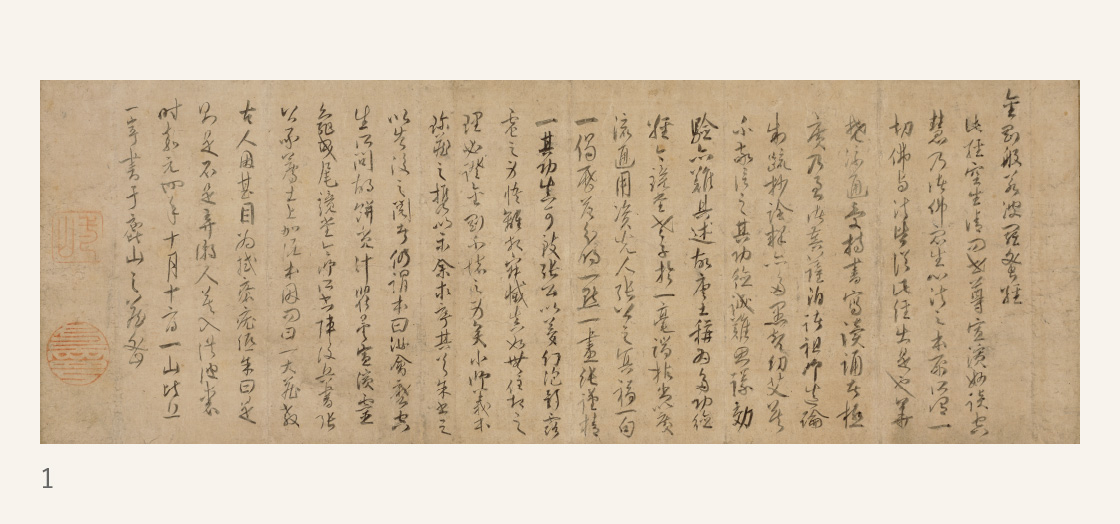
Chapter 1Scriptures – Buddhist Texts and Bokuseki Handwritten Texts
Buddhist teachings written by Zen founders in Bokuseki and glossaries
Important Cultural Property Yishan Yining Bokuseki Diamond Sutra Shokoku-ji Collection (Image 1)
Chinso Portrait of Mugaku Sogen Shun’oku Myoha Inscription Den-chusugo, author Jisho-in Collection
Collection Catalog Baiso Kenjo, author Daikomyo-ji Collection
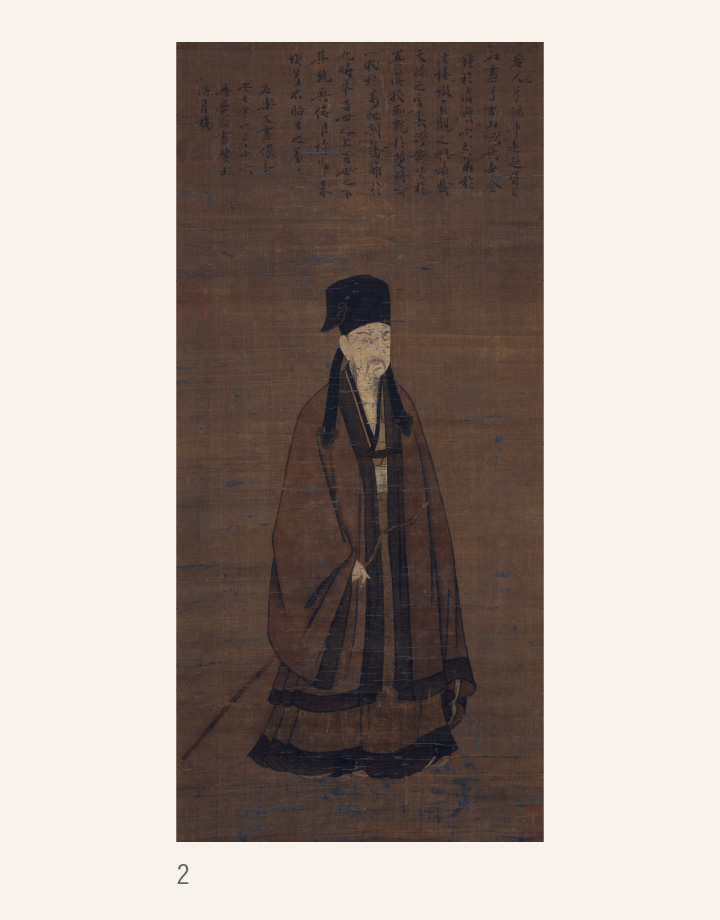
Chapter 2Apocrypha – Japanese-engraved Chinese books and Chinese paintings
Cultural artifacts brought from the continent included Buddhism as well as Confucian and Taoist teachings. The Zen temple was the disseminator of these cultures.
Empress Daimin Jinko Kanzensho texts Shokoku-ji Collection
Important Cultural Property Hakuraku-ten Painting Mugaku Sogen Inscription Den-chusugo Text Rokuon-ji Collection (Image 2)
Tao Yuan-ming Painting, Queen Akiko, author Shokoku-ji Collection
Akakabe Inkstone Kobatakei Inkwell Shokoku-ji Collection
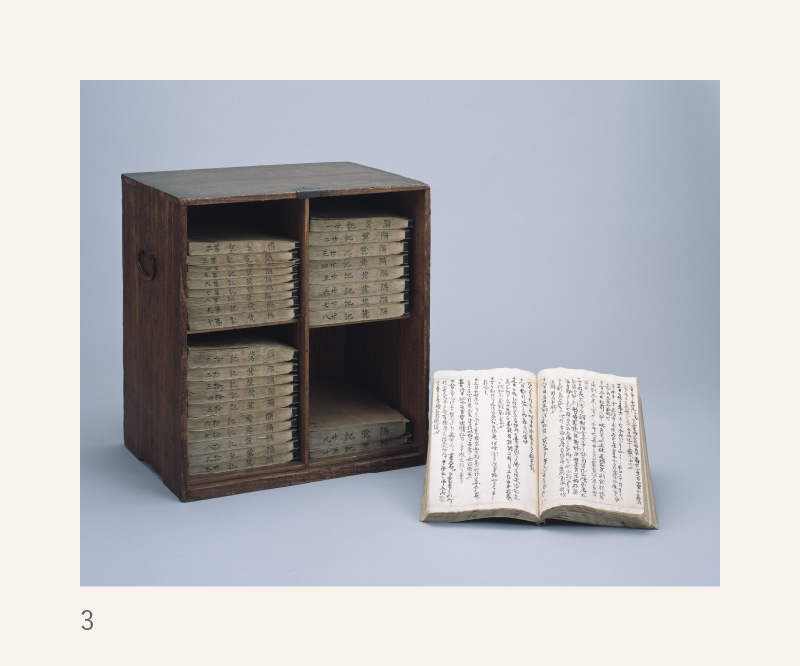
Chapter 3National Texts – Zen and Chinese Literature in the Early Modern Period
By publishing the Chinese poetry learned by the five Zen centers in the medieval period, a new segment of fans is gained, creating a new trend in the early modern period.
Kanzan Jittoku Painting Kao text Yishan Yining Inscription Shokoku-ji Collection
Kakumeiki Diary Shosho Text Rokuon-ji Collection (Image 3)
Meiyoshu Tobunshu Jisho-ji Collection
Sorin Fugetsu Rokurokukasen Jisho-in Collection
Eight Views of Xiaoxiang scroll painting Book by Monks at the Five Zen Centers Daikomyo-ji Collection
Fujiwara Seika statue Tomioka Tessai text Rinko-in Collection
[ Exhibition Room 2 ]
History and Treasures of Shokoku-ji Temple II
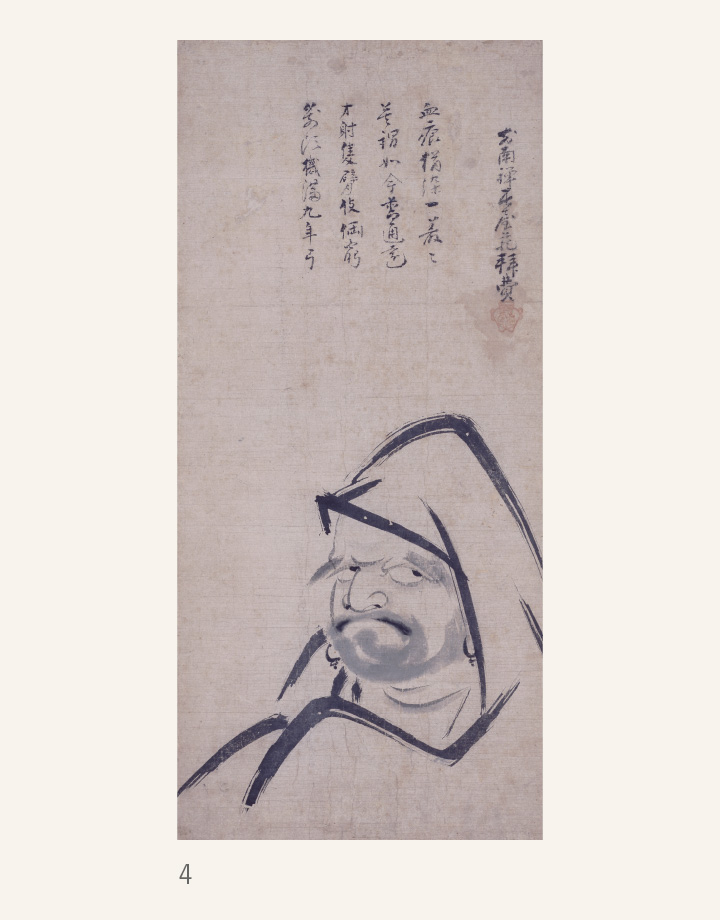
ⅠZen History and Shokoku-ji
Painting of Sakyamuni descending the mountain Yue-jiang Zheng-yin Inscription Indara text Rokuon-ji Collection
Daruma Doll drawing Shun’oku Myoha Inscription Gido Shushin Text Rokuon-ji Collection (Image 4)
Yishan Yining Bokuseki Sokuzao Kuranushi Kiri Buddhist Teachings Rokuon-ji Collection
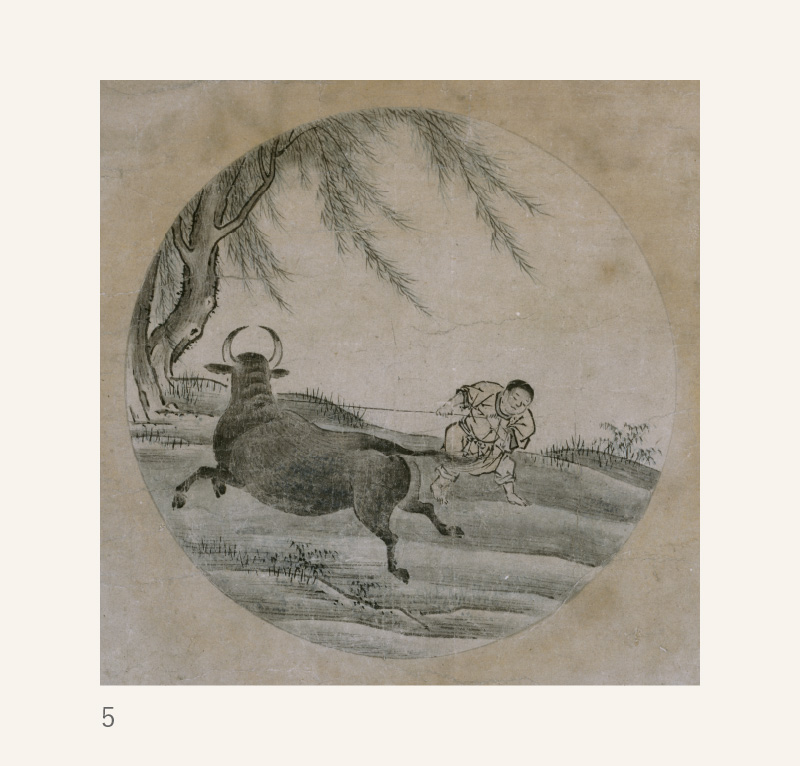
ⅡShokoku-ji in the Medieval Age
Important Cultural Property Ashikaga Yoshimitsu statue Ashikaga Yoshimochi Inscription Tosa Yukihiro Text Rokuon-ji Collection
Important Cultural Property Zekkai Chushin Bokuseki Ten Bulls Shokoku-ji Collection
Ten Bulls Paintings Shubun Text Shokoku-ji Collection (Image 5)
Important Cultural Property Jisho-in Ryoan Sohaku Jisho-in Collection
Shodanchiyo Bunmei Ittoki Den Ichijo Fuyuyoshi Text Shokoku-ji Collection
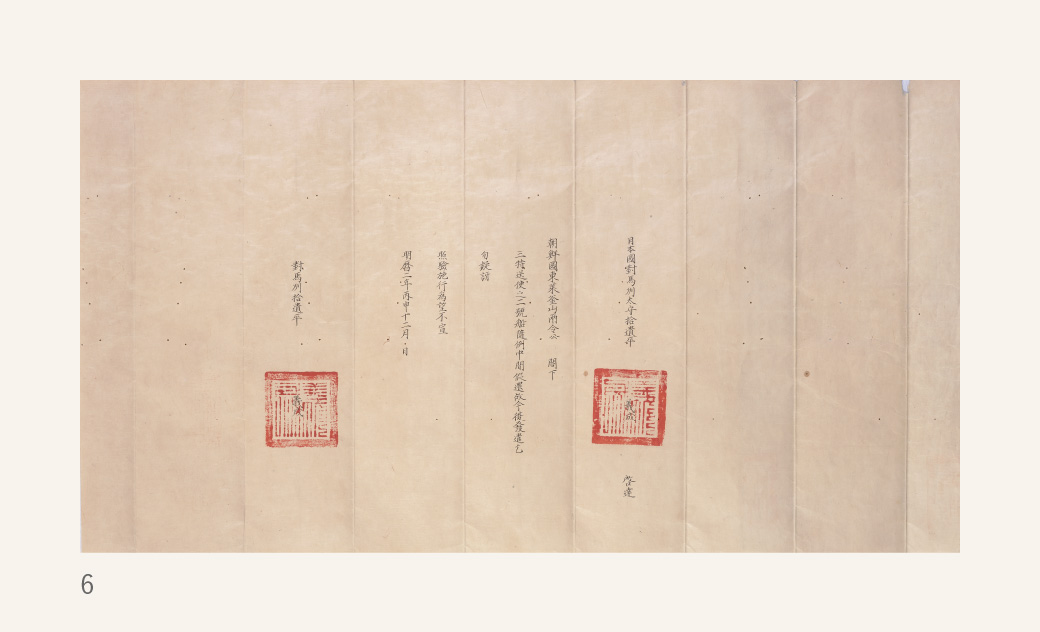
ⅢShokoku-ji in the early modern period
Tokugawa Ieyasu’s Black Seal Jisho-ji Collection
Important Cultural Property Foreign ship seals Saisho Shotai Text 13 texts Shokoku-ji Collection
Official document with Sō Yoshinari’s seal Shokoku-ji Collection (Image 6)
Tsushima Itei Grand View Jiun-in Collection

ⅣShokoku-ji in the Modern Age
Tansai Harukage Sansui Painting Xie Shichen Inscription Shokoku-ji Collection (Image 7)
Yuin Reading Painting Hashimoto Dokusan Inscription Shokoku-ji Collection
Seido Gishu Ryumonki Shokoku-ji Collection
ⅤAnnual Event
Portrait of Manjushri in hemp clothing, Motonobu Kano’s brush, Shokoku-ji Collection
Highlights
Highlights 140 works exhibited for the first time
The temple treasures include not only traditional fine art crafts and historical documents, but also books collected by the temples. By understanding what Zen monks learned, you can better appreciate the titles of traditional paintings and crafts and the content of Bokuseki. Besides Buddhism, Confucianism and Taoism were also included in their world view.
In the medieval period, Gozan Bungaku (Literature of the Five Mountains), which was concentrated in Shokoku-ji, was picked up by Confucian scholars in the early modern period. Also, the Tokugawa shogunate sent Zen monks who were expert in Chinese studies from the five Zen centers to Tsushima to handle diplomatic affairs. Documents related to Tsushima and Itei-an Temple, where the Zen monks were assigned, will also be exhibited for the first time.
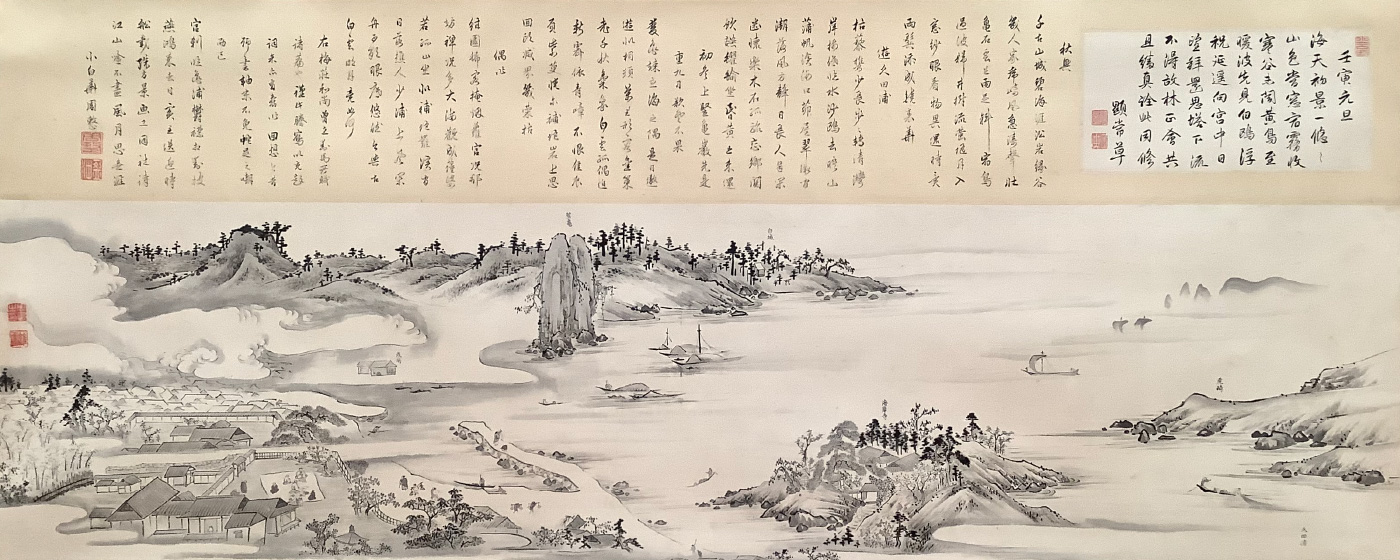
Tsushima Itei Grand View Jiun-in Collection
Highlights 2Ten Bulls, entire series of Ten Bulls paintings exhibited together
Among Shokoku-ji Shojo-in’s Important Cultural Properties, there is “Zekkai Chushin Bokuseki Ten Bulls.” Ten Bulls is a ten-step representation of the monk’s Zen training process, using a bull as a metaphor. The shepherd searches for a bull, follows signs of the bull, finds a bull, catches it, tames it, and then forgets about it. These “Ten Bulls” paintings were also inherited by Shokoku-ji.
This exhibition shows all the Ten Bulls paintings and text.
Exhibition Information
- When
- November 23rd, 2021 (Tue. and national holiday) to January 23rd, 2022 (Sun.)
10:00 a.m.–5:00 p.m. (enter by 4:30 p.m.)
< Closed >
December 27th, 2021 (Mon.)–January 5th, 2022 (Wed.) - Admission
-
General Admission ¥800 Age 65 and older and college students ¥600 Junior high and high school students ¥300 Elementary school students ¥200 *For the general public, ¥700 discount tickets available for groups of 20 people or more.
- Main Sponsor
- Shokoku-ji Jotenkaku Museum
- Secondary Sponsors
- Mannen-kai (Incorporated General Foundation), Rokuon-ji, Jisho-ji
Related Events
- November 27th (Sat.)
- 2:00 p.m.–3:30 p.m.Lecture: “The Power of Gozan Bungaku (Literature of the Five Mountains)
–Zen Monks as Ideal ‘Literati’ at Japan’s Five Zen Monastic Centers”
Lecturer: Dai Nakamoto (Professor, Faculty of Letters, Ritsumeikan University) - December 4th (Sat.)
- 2:00 p.m.–2:30 p.m.Slide presentation by Junko Honda (Museum Curator)
- December 18th (Sat.)
- 2:00 p.m.–3:30 p.m.Lecture by Junko Honda (Museum Curator)
- January 8th (Sat.)
- 2:00 p.m.–2:30 p.m.Slide presentation by Junko Honda (Museum Curator)
Press release
-
2021/10/25
Press release now available for “Zen Temple Studies: Continuing Gozan Bungaku (Literature of the Five Mountains) History and Treasures of Shokoku-ji Temple II”

